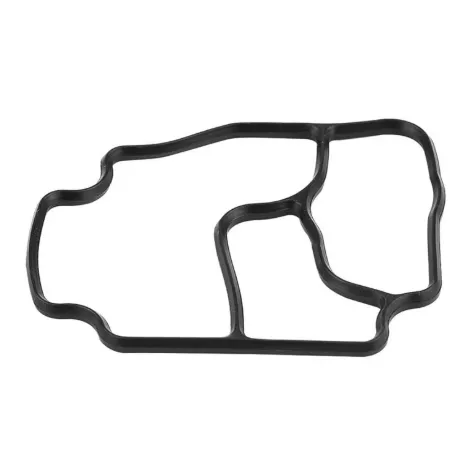Everything You Need to Know About Oil Pan Gaskets and Drain Plug Seals
Your engine relies on a precise balance of moving parts, pressure, and fluids—and a properly sealed oil pan and gasket system is critical to keeping it all working smoothly. The oil pan, located at the bottom of your engine, stores engine oil that lubricates and cools moving components. To prevent leaks and ensure long-term reliability, the connection between the engine and the oil pan is sealed with an engine oil pan gasket.
An engine oil pan gasket is a rubber, cork, or silicone-based barrier that forms a tight seal between the oil pan and the engine block. Its primary job is to prevent oil from leaking out where the two components meet. If this gasket wears out or gets damaged, it can cause oil leaks that lead to low oil levels, increased engine wear, and even serious damage.

Common symptoms of a failing pan gasket include:
Oil stains or puddles under your vehicle
Burning oil smell
Visible oil residue around the oil pan edges
Frequent low oil warnings on your dashboard
While the engine oil pan gasket is often out of sight, it should never be out of mind—especially if your vehicle is high-mileage or shows signs of oil leaks.
Don’t Forget the Small Parts: Oil Pan Plug Gasket and Drain Plug Gasket
When talking about sealing oil systems, many people focus only on the pan-to-engine connection. However, another small but crucial component is the oil pan drain plug gasket—also called the oil pan plug gasket. This thin washer-style seal sits between the oil drain plug and the oil pan to stop oil from leaking after every oil change.
A worn or missing oil pan plug gasket can result in a persistent oil drip from the bottom of the engine, even if the drain plug is tightened properly. Over time, repeated oil changes can cause the gasket to flatten, crack, or stick to the pan.
Types of oil pan drain plug gaskets include:
Crush washers (usually aluminum or copper): Designed to deform and seal tightly each time they’re used
Rubber or fiber gaskets: Offer good sealing and are reusable a limited number of times
Integrated gaskets: Found in some OEM drain plugs and require full plug replacement
Why it's important:
Replacing the oil pan drain plug gasket during every oil change ensures a tight seal and prevents small, hard-to-detect oil leaks that can eventually lead to larger problems or unnecessary oil consumption.
Replacing the Oil Pan and Gaskets: What You Need to Know
Whether you’re dealing with a worn engine oil pan gasket, a cracked oil pan, or a stripped drain plug thread, sometimes the best option is to replace the entire oil pan and gasket system. This is particularly common in older vehicles, cars with corrosion damage, or engines that have experienced impacts or bottoming out on the road.
When replacing your oil pan and gasket, follow these key steps:
- Drain the Oil
Completely drain the engine oil and safely discard or recycle it.
- Remove the Oil Pan
Remove all bolts securing the oil pan to the engine block. If the pan is stuck, gently use a rubber mallet or plastic scraper—never pry with metal tools, as they can damage the surface.
- Clean the Mating Surfaces
Use a degreaser and lint-free cloth to remove old gasket material and oil residue. A clean surface is critical for a leak-free seal.
- Install a New Engine Oil Pan Gasket
Place the new pan gasket carefully in position. Some gaskets require a small amount of RTV silicone in the corners or bolt holes—check the manufacturer’s recommendations.
- Reinstall the Oil Pan
Torque the bolts in a crisscross pattern to evenly compress the gasket and prevent warping.
- Replace the Oil Pan Plug Gasket
Before reinstalling the drain plug, don’t forget to add a fresh oil pan plug gasket to avoid leaks from the drain hole.
- Add Fresh Oil
Refill the engine with oil and run it briefly to check for leaks around the pan and plug area.
Pro Tip: If your oil pan has been removed or replaced multiple times, consider using a high-quality silicone engine oil pan gasket or a gasket with integrated sealing beads for a longer-lasting solution.
Seal the Deal with the Right Gaskets and Maintenance
From the large engine oil pan gasket to the small but mighty oil pan drain plug gasket, every seal in your oil system plays an essential role in keeping your vehicle running efficiently. Regular inspection and timely replacement of these components prevent leaks, protect engine health, and save you from costly repairs.
Key Takeaways:
The oil pan and gasket system prevents oil from leaking out of the engine
A failing pan gasket can cause visible oil drips and long-term engine wear
The oil pan plug gasket or oil pan drain plug gasket must be replaced with each oil change to ensure a tight seal
Always clean surfaces, use correct torque specs, and install gaskets carefully during replacements
Keeping your engine sealed and lubricated isn’t just about oil—it’s about the gaskets and small details that keep everything tight, clean, and reliable.
-
Seal 12x20x5: Precision Radial Shaft Seals for Industrial Reliability
ニュース Nov.24,2025
-
Seal 12x18x5: Essential Guide to Specifications, Applications & Vendors
ニュース Nov.24,2025
-
Understanding Seal 12 20 5: Applications, Specifications & Industry Insights
ニュース Nov.23,2025
-
Durable Oil Seal 85x110x12 – Reliable Sealing Solutions for Industry
ニュース Nov.23,2025
-
Durable and Precise Oil Seal 75x95x10 for Efficient Machinery | YJM Seal
ニュース Nov.22,2025
-
Durable Oil Seal 75x100x10 for Reliable Industrial Performance | YJM Seal
ニュース Nov.22,2025
-
High-Quality Oil Seal 65x90x10 | Durable & Reliable Sealing Solutions
ニュース Nov.22,2025
製品カテゴリー















